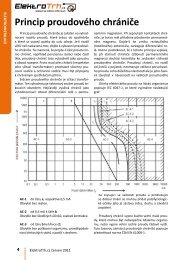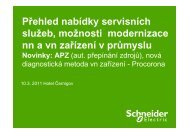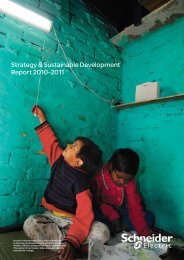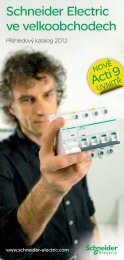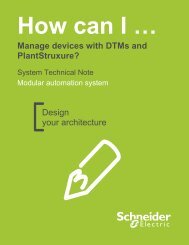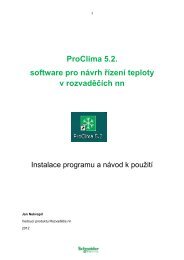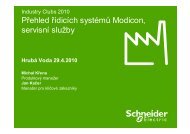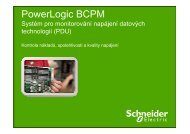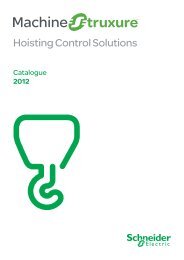2010Annual Report - Schneider Electric CZ, s.r.o.
2010Annual Report - Schneider Electric CZ, s.r.o.
2010Annual Report - Schneider Electric CZ, s.r.o.
You also want an ePaper? Increase the reach of your titles
YUMPU automatically turns print PDFs into web optimized ePapers that Google loves.
5 CONSOLIDATED FINANCIAL STATEMENTS<br />
NOTES TO THE CONSOLIDATED FINANCIAL STATEMENTS<br />
162<br />
Trademarks<br />
Trademarks acquired as part of a business combination are not<br />
amortised when they are considered to have an indefi nite life.<br />
The criteria used to determine whether or not such trademarks have<br />
indefi nite lives and, as the case may be, their lifespan, are as follows:<br />
• brand awareness;<br />
• outlook for the brand in light of the Group’s strategy for integrating<br />
the trademark into its existing portfolio.<br />
Non-amortised trademarks are tested for impairment at least<br />
annually and whenever there is an indication they may be impaired.<br />
When necessary, an impairment loss is recorded.<br />
Internally-generated intangible assets<br />
Research and development costs<br />
Research costs are expensed in the statement of income when<br />
incurred.<br />
Systems were set up to track and capitalise development costs<br />
in 2004. As a result, only development costs for new products<br />
launched since 2004 are capitalised in the IFRS accounts.<br />
Development costs for new projects are capitalised if, and only if:<br />
• the project is clearly identifi ed and the related costs are separately<br />
identifi ed and reliably tracked;<br />
• the project’s technical feasibility has been demonstrated and the<br />
Group has the intention and fi nancial resources to complete the<br />
project and to use or sell the resulting products;<br />
• the Group has allocated the necessary technical, fi nancial and<br />
other resources to complete the development;<br />
• it is probable that the future economic benefi ts attributable to the<br />
project will fl ow to the Group.<br />
Development costs that do not meet these criteria are expensed in<br />
the fi nancial year in which they are incurred.<br />
Capitalised development projects are amortised over the lifespan of<br />
the underlying technology, which generally ranges from 3 to 10 years.<br />
The amortisation of such capitalised projects is included in the cost<br />
of the related products and classifi ed into “Cost of sales” when the<br />
products are sold.<br />
Software implementation<br />
External and internal costs relating to the implementation of<br />
enterprise resource planning (ERP) applications are capitalised when<br />
they relate to the programming, coding and testing phase. They<br />
are amortised over the applications’ useful lives. In accordance with<br />
paragraph 98 of IAS 38, the SAP bridge application currently being<br />
rolled out within the Group is amortised using the unit method to<br />
refl ect the pattern in which the asset’s future economic benefi ts are<br />
expected to be consumed. Said units of production correspond to<br />
the number of users of the rolled-out solution divided by the number<br />
of target users at the end of the roll-out.<br />
2010 REGISTRATION DOCUMENT SCHNEIDER ELECTRIC<br />
1.10 - Property, plant and equipment<br />
Property, plant and equipment is primarily comprised of land,<br />
buildings and production equipment and is carried at cost, less<br />
accumulated depreciation and any accumulated impairment losses,<br />
in accordance with the recommended treatment in IAS 16 – Property,<br />
plant and equipment.<br />
Each component of an item of property, plant and equipment with a<br />
useful life that differs from that of the item as a whole is depreciated<br />
separately on a straight-line basis. The main useful lives are as<br />
follows:<br />
Buildings: 20 to 40 years<br />
Machinery and equipment: 3 to 10 years<br />
Other: 3 to 12 years<br />
The useful life of property, plant and equipment used in operating<br />
activities, such as production lines, refl ects the related products’<br />
estimated life cycles.<br />
Useful lives of items of property, plant and equipment are reviewed<br />
periodically and may be adjusted prospectively if appropriate.<br />
The depreciable amount of an asset is determined after deducting<br />
its residual value, when the residual value is material.<br />
Depreciation is expensed in the period or included in the production<br />
cost of inventory or the cost of internally-generated intangible<br />
assets. It is recognised in the statement of income under “Cost of<br />
sales”, “Research and development costs” or “Selling, general and<br />
administrative expenses”, as the case may be.<br />
Items of property, plant and equipment are tested for impairment<br />
whenever there is an indication they may have been impaired.<br />
Impairment losses are charged to the statement of income under<br />
“Other operating income and expenses”.<br />
Leases<br />
The assets used under leases are recognised in the balance sheet,<br />
offset by a fi nancial debt, where the leases transfer substantially all<br />
the risks and rewards of ownership to the Group.<br />
Leases that do not transfer substantially all the risks and rewards of<br />
ownership are classifi ed as operating leases. The related payments<br />
are recognised as an expense on a straight-line basis over the lease<br />
term.<br />
Borrowing costs<br />
In accordance with IAS 23 R – Borrowing costs (applied as of<br />
January 1, 2009), borrowing costs that are directly attributable to<br />
the acquisition, construction or production of a qualifying asset are<br />
capitalised as part of the cost of the asset when it is probable that<br />
they will result in future economic benefi ts to the entity and the costs<br />
can be measured reliably. Other borrowing costs are recognised as<br />
an expense for the period. Prior to January 1, 2009, borrowing costs<br />
were systematically expensed when incurred.




